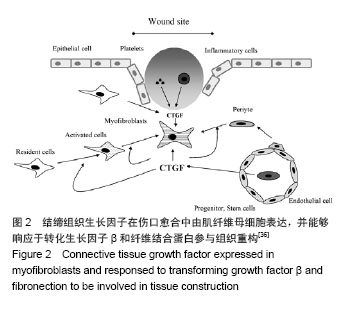| [1]Penn JW, Grobbelaar AO, Rolfe KJ. The role of the TGF-beta family in wound healing, burns and scarring: a review. Int J Burns Trauma.2012;2(1):18-28.
[2]Shi-wen X, Pennington D, Holmes A, et al. Autocrine overexpression of CTGF maintains fibrosis: RDA analysis of fibrosis genes in systemic sclerosis. Exp Cell Res.2000; 259(1):213-224.
[3]Bradham DM, Igarashi A, Potter RL, et al. Connective tissue growth factor: a cysteine-rich mitogen secreted by human vascular endothelial cells is related to the SRC-induced immediate early gene product CEF-10. J Cell Biol. 1991; 114(6):1285-1294.
[4]胡振富,高建华,李薇,等.瘢痕疙瘩的差异表达基因谱研究[J].南方医科大学学报,2006,26(3):308-312.
[5]向小燕,岑瑛.结缔组织生长因子与病理性瘢痕[J]. 西部医学, 2005,17(2):178-180.
[6]Kapoor M, Liu S, Huh K, et al. Connective tissue growth factor promoter activity in normal and wounded skin. Fibrogenesis Tissue Repair.2008;1(1):3.
[7]Chen CC, Lau LF. Functions and mechanisms of action of CCN matricellular proteins. Int J Biochem Cell Biol.2009; 41(4):771-783.
[8]Minhas U, Martin TA, Ruge F, et al. Pattern of expression of CCN family members Cyr61, CTGF and NOV in human acute and chronic wounds.Exp Ther Med.2011;2(4):641-645.
[9]Rittie L, Perbal B, Castellot JJ, et al. Spatial-temporal modulation of CCN proteins during wound healing in human skin in vivo. J Cell Commun Signal. 2011;5(1):69-80.
[10]王勇,王少华,唐胜建,等.病理性瘢痕中结缔组织生长因子的表达及其意义[J].中国美容医学, 2008,17(11):1628-1630.
[11]Ivkovic S, Yoon BS, Popoff SN, et al. Connective tissue growth factor coordinates chondrogenesis and angiogenesis during skeletal development. Development. 2003;130(12): 2779-2791.
[12]Chaqour B. Molecular control of vascular development by the matricellular proteins CCN1 (Cyr61) and CCN2 (CTGF). Trends Dev Biol.2013;7:59-72.
[13]Alfaro MP, Deskins DL, Wallus M, et al. A physiological role for connective tissue growth factor in early wound healing. Lab Invest.2013;93(1):81-95.
[14]Mustoe TA. Scars and Keloids:Several treatments are used,but the evidence base is lacking. BMJ.2004;328(7452): 1329.
[15]Kiwanuka E, Andersson L, Caterson EJ, et al. CCN2 promotes keratinocyte adhesion and migration via integrin alpha5beta1. Exp Cell Res. 2013;319(19):2938-2946.
[16]Liu S, Thompson K, Leask A. CCN2 expression by fibroblasts is not required for cutaneous tissue repair. Wound Repair Regen.2014;22(1):119-124.
[17]Sisco M, Kryger ZB, O'Shaughnessy KD, et al. Antisense inhibition of connective tissue growth factor (CTGF/CCN2) mRNA limits hypertrophic scarring without affecting wound healing in vivo. Wound Repair Regen.2008;16(5):661-673.
[18]Bonniaud P, Martin G, Margetts PJ, et al. Connective tissue growth factor is crucial to inducing a profibrotic environment in "fibrosis-resistant" BALB/c mouse lungs. Am J Respir Cell Mol Biol.2004;31(5):510-516.
[19]Leask A. Transcriptional profiling of the scleroderma fibroblast reveals a potential role for connective tissue growth factor (CTGF) in pathological fibrosis. Keio J Med.2004;53(2):74-77.
[20]Geisinger MT, Astaiza R, Butler T, et al. Ets-1 is essential for connective tissue growth factor (CTGF/CCN2) induction by TGF-beta1 in osteoblasts. PLoS One. 2012;7(4):e35258.
[21]Daniels A, Van Bilsen M, Goldschmeding R, et al. Connective tissue growth factor and cardiac fibrosis. Acta physiologica. 2009;195(3):321-338.
[22]Liu LD, Shi HJ, Jiang L, et al. The repairing effect of a recombinant human connective-tissue growth factor in a burn-wounded rhesus-monkey (Macaca mulatta) model. Biotechnol Appl Biochem.2007;47(Pt 2):105-112.
[23]Czubryt MP. Common threads in cardiac fibrosis, infarct scar formation, and wound healing. Fibrogenesis Tissue Repair. 2012;5(1):19.
[24]Kiwanuka E, Andersson L, Caterson EJ, et al. CCN2 promotes keratinocyte adhesion and migration via integrin alpha5beta1.Exp Cell Res. 2013;319(19):2938-2946.
[25]谢正福,余书勤.重组人结缔组织生长因子(rhCTGF)促进大鼠烫伤创面愈合的实验研究[J]. 广东药学院学报, 2005,21(2):178-182.
[26]Ponticos M. Connective tissue growth factor (CCN2) in blood vessels. Vascul Pharmacol.2013;58(3):189-193.
[27]Colwell AS, Phan TT, Kong W, et al. Hypertrophic scar fibroblasts have increased connective tissue growth factor expression after transforming growth factor-beta stimulation. Plast Reconstr Surg.2005;116(5):1387-1390, 1391-1392.
[28]Wehrhan F, Rodel F, Grabenbauer GG, et al. Transforming growth factor beta 1 dependent regulation of Tenascin-C in radiation impaired wound healing. Radiother Oncol.2004; 72(3):297-303.
[29]Fan MS, Jiang ZY, Zou YF, et al. [Effect of transforming growth factor beta1 on the expression of matrix metalloproteinase 9, tissue inhibitor of metalloproteinase 1 and nuclear factor kappa B signalling pathway in the human amniotic cells WISH]. Zhonghua Fu Chan Ke Za Zhi. 2013; 48(1):29-33.
[30]Ohno S, Hirano S, Kanemaru S, et al. Transforming growth factor beta3 for the prevention of vocal fold scarring. Laryngoscope.2012;122(3):583-589.
[31]Igarashi A, Nashiro K, Kikuchi K, et al. Connective tissue growth factor gene expression in tissue sections from localized scleroderma, keloid, and other fibrotic skin disorders. J Invest Dermatol.1996;106(4):729-733.
[32]Mun JH,Kim YM,Kim BS,et al.Simvastatin inhibits transforming growth factor-beta1-induced expression of type I collagen, CTGF, and alpha-SMA in keloid fibroblasts. Wound Repair Regen.2014;22(1):125-133.
[33]Lee CH, Shah B, Moioli EK, et al. CTGF directs fibroblast differentiation from human mesenchymal stem/stromal cells and defines connective tissue healing in a rodent injury model. J Clin Invest.2010;120(9):3340-3349.
[34]Wynn TA.Cellular and molecular mechanisms of fibrosis.J pathol. 2008;214(2):199-210.
[35]Jun JI, Lau LF. Cellular senescence controls fibrosis in wound healing. Aging (Albany NY).2010;2(9):627-631.
[36]Shi-Wen X, Leask A, Abraham D. Regulation and function of connective tissue growth factor/CCN2 in tissue repair, scarring and fibrosis. Cytokine & growth factor reviews. 2008; 19(2): 133-144.
[37]Hall-Glenn F, Lyons K M. Roles for CCN2 in normal physiological processes. Cellular and Molecular Life Sciences. 2011;68(19): 3209-3217. |


.jpg)
.jpg)